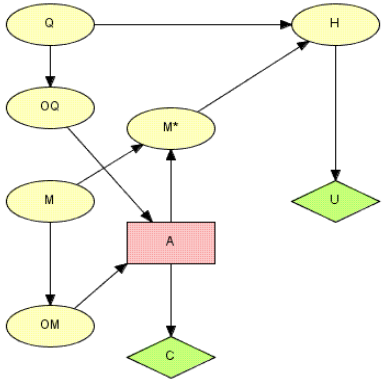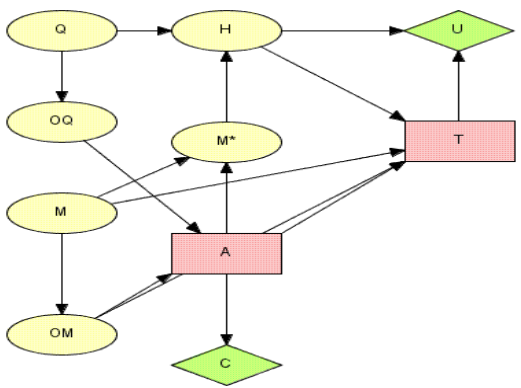The Mildew examples¶
These examples originates from An introduction to Bayesian Networks.
The networks shown in this example have been installed on your computer with the HUGIN software. Open the network in the HUGIN Graphical User Interface (Note: not all browsers can open HUGIN directly). You can find the networks in the directory where you installed HUGIN.
You can also find the samples at the HUGIN download area.
The basic situation¶
Approximately two months before harvesting a wheat field a farmer can observe the state of the crop and he can observe whether it has been attacked by mildew. If there is an attack he should decide on a treatment with fungicides.
The limited memory influence diagram below models this situation:

There are five chance nodes:
The actual state of the crop, Q with states fair (f), average (a), good (g) and very good (v).
The actual mildew-situation, M with states no, little (l), moderate (m) and severe (s).
The state of the crop at harvest time, H with the states from Q plus rotten (r), bad (b) and poor (p).
The observation, OQ, of Q.
The observation, OM, of M.
There is also an action node, A (modeling the fungicide-treatment) with actions no, light (l), moderate (m) and heavy (h).
Now we extend the example with a decision on the time of harvest (T). This decision is to be made two months after the decision on fungicides. Note that H models the state of the field at the time of decision T.
When there are more than one decision node in the model, the computation of the expected utility of an action requires knowledge of what will be known when future decisions are made. For each decision node it is important to specify using Informational links the information known to the decision maker at the corresponding decision. A link from node X to decision node D indicates that the state of X is known when the decision on D is made.
The model depends on what information is available at the time of deciding on T. We present four different scenarios:
Scenario 1¶
In this scenario there is no further information.

HUGIN computes the (optimal) strategy by Single Policy Updating and the expected utility function and the posterior probability distribution for each node under the strategy.
Scenario 2¶
In this scenario the state of H is known. This means that there is a link from H to T. A link from a chance node to a decision node means that evidence on the chance node has to be available at the time of the decision in order for the utilities to be computed correctly.

Scenario 3¶
In this scenario there is an observation on H available, but it is imprecise, so it doesn’t necessarily show the actual state of the crop. Still it has an impact on our belief in the state of H and also on the expected utilities of the various possibilities for T.

Scenario 4¶
In this scenario the farmer does not recall the observations on OQ and OM made prior to decision A nor does he recall the decision made at A. In this example the policy on T is a function of OH only.
